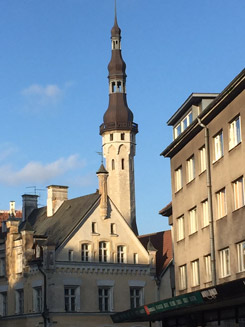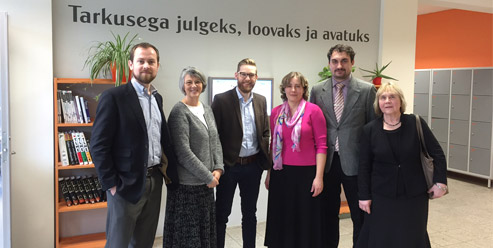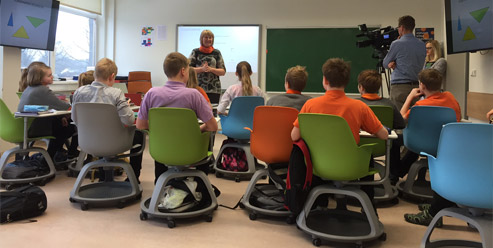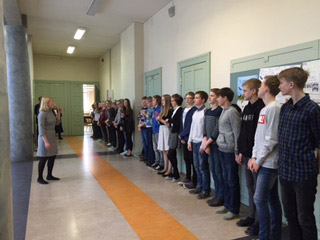I don't think I'd knowingly met an Estonian before this week. Nestled in the top right hand corner of Europe, bordered by Russia and Latvia and across the sea from Finland and Sweden, Estonia has only recently become more accessible via the budget airlines. However if you're interested in maths education, Estonia is up there in the international league tables and therefore a country to watch.
The history

It's important to understand the history of this little country, with only 1.3 million inhabitants, a history peppered with invasion and war, sadness and cruelty, and various tries at independence. Over a quarter of the population speak Russian as a first language and there are schools that cater specifically for this cohort of children. Levels of literacy are high and everyone, except the very young and very old, speaks English. Perhaps because of the history, there is a strong sense of culture, evident especially in the Song Festival which occurs every five years and features over 40,000 performers.
Seemingly, when Estonia regained its independence from the Soviet Union in 1991, less than half its population had a telephone line and its only independent link to the outside world was a Finnish mobile phone concealed in the foreign minister's garden! Twenty-five years later it’s a world leader in technology. This is the country that brought us Skype and TransferWise, successfully implemented online voting and digital record-keeping for their health service, where you can log on to the Internet practically everywhere and whose strapline is 'positively surprising'. The e-culture pervades education and by 1998 all schools were online. And whether it’s because of that, or despite it, Estonia does well in PISA and TIMMS. So an invitation to Tartu University to find out about the mathematics curriculum and the embedding of technology seemed like a good idea for the Cambridge Mathematics Team.
The classroom ethos
Estonian primary classes increase with age – from less than 20 in primary to between 30 and 40 for older students. Teachers in primary school stay with their class for four years and find our pattern of changing every year bizarre. School starts at seven years of age and prior to that children are taught at home or in a nursery environment. Interestingly, even young children are expected to be independent; for example those who start school at midday will often be at home alone in the mornings and make their own way to school.

In the three classrooms that we visited we focused on the use of digital technology. In two it was the use of iPads – each child had their own, was fluent in its use, which really was embedded in the lesson and only used where there was a really good reason. Teachers talked enthusiastically about the affordances of IT and in all the lessons that we saw they were happy to complement it with other activity, such as paper folding. In the third classroom we observed Computer Based Maths (CBM) in practice. This is a statistics focused project jointly designed by Wolfram and Estonian maths education specialists. Hitherto this has been a very small part of the Estonian curriculum. We were interested in finding out how the teacher managed to keep all of a mixed ability class on the same track, and whether the Mathematica platform supported an educationally sound and realistic problem solving experience – two issues that were particularly pertinent to us as Cambridge Mathematics has been exploring a similar project in the UK but focusing on geometry.

Textbooks
Estonia trends seem to be at odds with ours. Just as we are ensuring that every classroom has an interactive white board, in Estonia they have retained the digital projector but prefer to use hand held technology for both display and individual use. And as we debate the importance of well-designed textbooks, Estonian teachers prefer their own resources to the mandatory use of textbooks under the Russian regime.
The teaching profession and the curriculum

All teacher training is university based and takes four years. Most Estonian teachers are female and, as with the UK, teacher recruitment is an issue. Working conditions seem to be good and there is a huge amount of autonomy in when and how to teach in that the curriculum is described in courses which require a prescribed number of hours only. There is more data handling now than previously but no applied maths, such as mechanics, at all. Curriculum reform happens when there is a perceived need to adjust it rather than being in a fixed cycle and the impetus for a change comes from the teaching profession.
Visiting another country makes one reflect on what is the norm here at home. Estonian teachers are well-trained and guard their independence and autonomy jealously. They are left to make their own decisions based on their knowledge of the subject and their students, and assessment is for the purposes of the student body rather than for accountability. There is a heavy emphasis on the creative curriculum with cultural education being regarded as absolutely essential. It will be interesting to see if in the next few years the Estonian education policy retains these distinctions or whether, as was hinted at, they will move to greater centralisation and national testing. And whether they stay up there in PISA...
Here’s a link to an article in the national press about our visit – http://arvamus.postimees.ee/3623111/matemaatikat-on-vaja-et-olla-enesekindel-kodanik
And an Estonian colleague in our Group Printing and Operations team has kindly provided an English translation of the article.
Lynne McClure
Director, Cambridge Mathematics